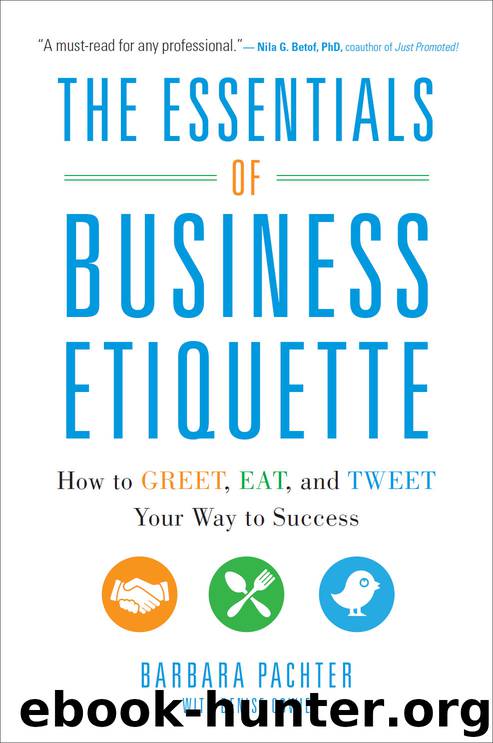The Essentials of Business Etiquette by Barbara Pachter

Author:Barbara Pachter
Language: eng
Format: epub, pdf
Publisher: McGraw-Hill Education
Published: 2013-06-22T16:00:00+00:00
52. Wine Tales: Don’t Wave Your Hand over the Glass
A dining scene from Last Holiday, a 2006 comedy with Queen Latifah, caught my attention recently as I was channel surfing. Watching people dine in formal restaurants can provide good stories for my etiquette seminars—think Pretty Woman and escargot flying across the room.
This fun movie was no exception. During the meal, a diner put his hand over his glass to signal that he didn’t want any more wine—just as the waiter poured the wine onto his hand!
Listed below is the way to avoid a wet hand, plus additional suggestions to help you feel more comfortable dealing with wine in a restaurant:
1. Avoid gesturing. If you don’t want any more wine, simply say “No, thank you” to the waiter.
2. Learn about wine. If you are the host, you are in charge of the wine selection. You can defer to your guests, but then you may end up with a $300 bottle of wine that was not in your budget. There are many books and websites with lots of information about wine. You can also take a class at an adult-education school or a wine store. The general guideline is that white wine is served with fish and poultry and red wine with meat, but there are numerous exceptions.
3. Ask the sommelier (wine steward) for suggestions. Most wine stewards are very knowledgeable and will be happy to pair your food choices with wine.
4. Use my acronym LaCEST™ to help you remember the wine-tasting steps:
• La stands for label. The wine steward will show the host (or the person who ordered the bottle) the label from the bottle. You look at the label and nod approval that you have received the wine you ordered.
• C stands for cork. The wine steward opens the bottle and places the cork on the table. Check the cork. The cork shouldn’t be dry and crumbly.
• E stands for examine. The wine steward pours a small amount of wine into your glass. Examine the appearance of the wine. Check the color and clarity.
• S stands for swirl and smell. Gently swirl the wine to release the aroma and then take a sniff. If you like what you smell, chances are that it will be a good bottle.
• T stands for taste. Take a sip and nod approval. You reject wine only if there is a problem with the wine quality. You don’t send back wine if it is not to your liking. Your guests’ glasses are filled first, and then yours.
Though there are five steps involved, wine tasting is a relatively quick process. Don’t turn it into a major production.
TRY THIS SUGGESTION
As the host, you can make a short, informal toast at the beginning of the meal to welcome your guests. Raise your glass and say something like, “It’s really wonderful that we can all be together to celebrate the successful launch of our new product. And I would like to thank every one of you for your effort.
Download
The Essentials of Business Etiquette by Barbara Pachter.pdf
This site does not store any files on its server. We only index and link to content provided by other sites. Please contact the content providers to delete copyright contents if any and email us, we'll remove relevant links or contents immediately.
| Ethics | Etiquette |
| Fashion & Image | Health & Stress |
| Motivation & Self-Improvement | Work Life Balance |
| Workplace Culture |
Tools of Titans by Timothy Ferriss(6938)
Change Your Questions, Change Your Life by Marilee Adams(6637)
Deep Work by Cal Newport(5452)
Man-made Catastrophes and Risk Information Concealment by Dmitry Chernov & Didier Sornette(4730)
Big Magic: Creative Living Beyond Fear by Elizabeth Gilbert(4719)
The Slight Edge by Jeff Olson(4716)
The Motivation Myth by Jeff Haden(4521)
Digital Minimalism by Cal Newport;(4512)
Stone's Rules by Roger Stone(4413)
Ego Is the Enemy by Ryan Holiday(3982)
The Laws of Human Nature by Robert Greene(3936)
Tuesdays with Morrie by Mitch Albom(3830)
Rising Strong by Brene Brown(3777)
Eat That Frog! by Brian Tracy(3509)
Skin in the Game by Nassim Nicholas Taleb(3456)
The Money Culture by Michael Lewis(3277)
Skin in the Game: Hidden Asymmetries in Daily Life by Nassim Nicholas Taleb(3259)
Believe It to Achieve It by Brian Tracy & Christina Stein(3201)
Bullshit Jobs by David Graeber(3173)
